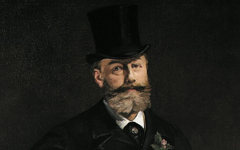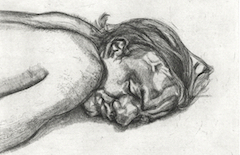Freud’s Self-portrait: Reflection (2002)
Unless you know that Lucian Freud's paradigm is art's there is not much to say about his self-portraits though, like all art, you can read into them what you want. Some writers, crediting the influence of his grandfather, Sigmund Freud, believe that they have deep psychological insight. Yet this widely-used method of interpretation is so closely related to physiognomy, the long-dismissed pseudo-science of prior centuries, that it is clearly inappropriate. Physiognomy allowed "experts" to determine a person's character through how they looked and, even though the method fell from favor in the late 19th century, it still led to Hitler and the Holocaust. There are other ways to make original contributions.
Click next thumbnail to continue

L: Freud, Portrait of Queen Elizabeth II (2002) Oil on canvas. HM Queen.
R: Diagram of Freud's Self-portrait: Reflection (2002)
Click image to enlarge.
Freud painted his portrait in 2002, the same year he asked Queen Elizabeth if he could paint hers. The royal portrait is clearly part of the long tradition of artist-as-monarch.1 That is why the likeness is so poor: he has fused his features into her face. She is the monarch in his mind.2 There is more evidence in his coiffure. His untamed silver mane is shaped like the central Cross in the Queen's crown and of similar color (see diagram).
Click next thumbnail to continue
Within his face - and remember, like all art, this is a mental image - are two old men arguing, in profile from either side of his head. See diagram. Each uses one of the artist's eyes as his "open mouth". They are possibly distorted (caricatural) images of the artist's own features, an attempt to depict his mental self-image.3 Art, he seems to say, is the product of internal argument between different forms of visual perception. Perhaps that's why he turned the eyes into mouths in a modern depiction of an artist's creative struggle (read more.)
Down below in his hand (not shown at left) is an even more abstract image of an earlier self-portrait whose title, perhaps a hint from the artist, is the exact opposite, as in a reflection, of this one.
Click next thumbnail to continue

Top: Detail of of Freud's Self-portrait: Reflection
Lower L: Detail of Freud's Reflection: Self-portrait (1981-2) inverted
Lower R: Diagram of Freud's Self-portrait: Reflection
Click image to enlarge.
One is called Reflection: Self-portrait (detail, lower left); the other Self-portrait: Reflection. (He included an image of the former in the Queen's portrait as well.)4 See here how his "eye" is in the gap between thumb and index finger (see diagram, lower right), darkened to suggest insight. His wavy "eyebrow" is in the upper contour of his thumb; the lower part of his nose in his bent forefinger; his receding lower lip in the ring finger; and his rounded chin at the bottom. A mental image inside a mental image, it depicts the creative process through which this painting was developed. His hand (craft) is united with his head (intellect) as he mentally turns one self-portrait into another.
Click next thumbnail to continue
The many references to royalty in artists' self-portraits, as here, is not just a symbol of social rank, or of the art's quality, but has spiritual meaning as a sign of the mind's purity. Both Buddha and Moses were said to have been born as princes for the same reason. Jesus became King of the Jews. The Egyptian pharaohs were always gods.
On the superficial level it is ironic that the painting in the background is entirely abstract when Freud was once criticized for only painting "from nature". Abstraction, though, is a depiction of the creative process, of visual ideas taking shape. The depicted canvas is thus an image of Freud's underlying mind, his subconscious depicted as though it were an intricate network of neurons and synapses, that in some mysterious way help coagulate his chaotic mass of sensory input into recognizable forms.
More Works by Freud
Notes:
1. See the theme under Alter Ego in the left margin, Artist as King.
2. The earliest example of the artist-as-monarch yet found is Fouquet's 1450 Portrait of Charles VII of France. I have already published two entries explaining Freud's Portrait of Queen Elizabeth II (2002).
3. For more on how mental images are often distorted, see Cubism Explained.
4. See Abrahams, Lucian Freud's Queen Elizabeth II, Part 2, published 23rd July 2011.
Original Publication Date on EPPH: 03 Oct 2013. © Simon Abrahams. Articles on this site are the copyright of Simon Abrahams. To use copyrighted material in print or other media for purposes beyond 'fair use', you must obtain permission from the copyright owner. Websites may link to this page without permission (please do) but may not reproduce the material on their own site without crediting Simon Abrahams and EPPH.





